Yinghui Li
SpecRouter: Adaptive Routing for Multi-Level Speculative Decoding in Large Language Models
May 12, 2025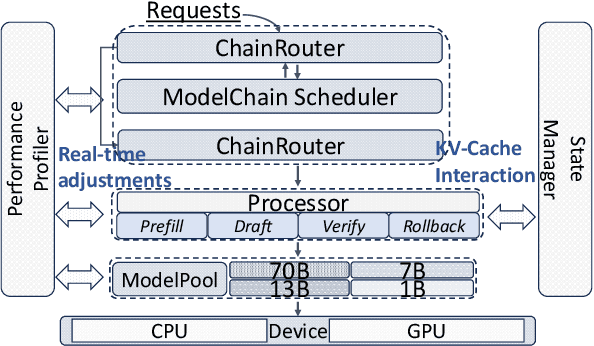

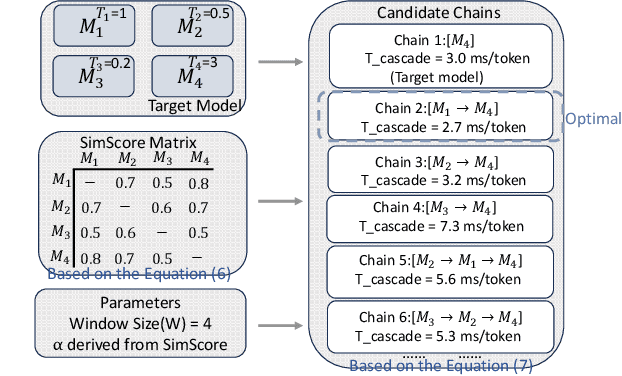
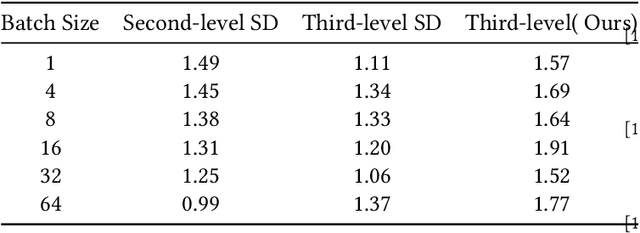
Abstract:Large Language Models (LLMs) present a critical trade-off between inference quality and computational cost: larger models offer superior capabilities but incur significant latency, while smaller models are faster but less powerful. Existing serving strategies often employ fixed model scales or static two-stage speculative decoding, failing to dynamically adapt to the varying complexities of user requests or fluctuations in system performance. This paper introduces \systemname{}, a novel framework that reimagines LLM inference as an adaptive routing problem solved through multi-level speculative decoding. \systemname{} dynamically constructs and optimizes inference "paths" (chains of models) based on real-time feedback, addressing the limitations of static approaches. Our contributions are threefold: (1) An \textbf{adaptive model chain scheduling} mechanism that leverages performance profiling (execution times) and predictive similarity metrics (derived from token distribution divergence) to continuously select the optimal sequence of draft and verifier models, minimizing predicted latency per generated token. (2) A \textbf{multi-level collaborative verification} framework where intermediate models within the selected chain can validate speculative tokens, reducing the verification burden on the final, most powerful target model. (3) A \textbf{synchronized state management} system providing efficient, consistent KV cache handling across heterogeneous models in the chain, including precise, low-overhead rollbacks tailored for asynchronous batch processing inherent in multi-level speculation. Preliminary experiments demonstrate the validity of our method.
From Token to Line: Enhancing Code Generation with a Long-Term Perspective
Apr 10, 2025Abstract:The emergence of large language models (LLMs) has significantly promoted the development of code generation task, sparking a surge in pertinent literature. Current research is hindered by redundant generation results and a tendency to overfit local patterns in the short term. Although existing studies attempt to alleviate the issue by adopting a multi-token prediction strategy, there remains limited focus on choosing the appropriate processing length for generations. By analyzing the attention between tokens during the generation process of LLMs, it can be observed that the high spikes of the attention scores typically appear at the end of lines. This insight suggests that it is reasonable to treat each line of code as a fundamental processing unit and generate them sequentially. Inspired by this, we propose the \textbf{LSR-MCTS} algorithm, which leverages MCTS to determine the code line-by-line and select the optimal path. Further, we integrate a self-refine mechanism at each node to enhance diversity and generate higher-quality programs through error correction. Extensive experiments and comprehensive analyses on three public coding benchmarks demonstrate that our method outperforms the state-of-the-art performance approaches.
MDIT: A Model-free Data Interpolation Method for Diverse Instruction Tuning
Apr 09, 2025Abstract:As Large Language Models (LLMs) are increasingly applied across various tasks, instruction tuning has emerged as a critical method for enhancing model performance. However, current data management strategies face substantial challenges in generating diverse and comprehensive data, restricting further improvements in model performance. To address this gap, we propose MDIT, a novel model-free data interpolation method for diverse instruction tuning, which generates varied and high-quality instruction data by performing task interpolation. Moreover, it contains diversity-based clustering strategies to ensure the diversity of the training data. Extensive experiments show that our method achieves superior performance in multiple benchmark tasks. The LLMs finetuned with MDIT show significant improvements in numerous tasks such as general question answering, math reasoning, and code generation. MDIT offers an efficient and automatic data synthetic method, generating diverse instruction data without depending on external resources while expanding the application potential of LLMs in complex environments.
RAISE: Reinforenced Adaptive Instruction Selection For Large Language Models
Apr 09, 2025Abstract:In the instruction fine-tuning of large language models (LLMs), it has become a consensus that a few high-quality instructions are superior to a large number of low-quality instructions. At present, many instruction selection methods have been proposed, but most of these methods select instruction based on heuristic quality metrics, and only consider data selection before training. These designs lead to insufficient optimization of instruction fine-tuning, and fixed heuristic indicators are often difficult to optimize for specific tasks. So we designed a dynamic, task-objective-driven instruction selection framework RAISE(Reinforenced Adaptive Instruction SElection), which incorporates the entire instruction fine-tuning process into optimization, selecting instruction at each step based on the expected impact of instruction on model performance improvement. Our approach is well interpretable and has strong task-specific optimization capabilities. By modeling dynamic instruction selection as a sequential decision-making process, we use RL to train our selection strategy. Extensive experiments and result analysis prove the superiority of our method compared with other instruction selection methods. Notably, RAISE achieves superior performance by updating only 1\% of the training steps compared to full-data training, demonstrating its efficiency and effectiveness.
Corrections Meet Explanations: A Unified Framework for Explainable Grammatical Error Correction
Feb 21, 2025Abstract:Grammatical Error Correction (GEC) faces a critical challenge concerning explainability, notably when GEC systems are designed for language learners. Existing research predominantly focuses on explaining grammatical errors extracted in advance, thus neglecting the relationship between explanations and corrections. To address this gap, we introduce EXGEC, a unified explainable GEC framework that integrates explanation and correction tasks in a generative manner, advocating that these tasks mutually reinforce each other. Experiments have been conducted on EXPECT, a recent human-labeled dataset for explainable GEC, comprising around 20k samples. Moreover, we detect significant noise within EXPECT, potentially compromising model training and evaluation. Therefore, we introduce an alternative dataset named EXPECT-denoised, ensuring a more objective framework for training and evaluation. Results on various NLP models (BART, T5, and Llama3) show that EXGEC models surpass single-task baselines in both tasks, demonstrating the effectiveness of our approach.
Revisiting Classification Taxonomy for Grammatical Errors
Feb 18, 2025Abstract:Grammatical error classification plays a crucial role in language learning systems, but existing classification taxonomies often lack rigorous validation, leading to inconsistencies and unreliable feedback. In this paper, we revisit previous classification taxonomies for grammatical errors by introducing a systematic and qualitative evaluation framework. Our approach examines four aspects of a taxonomy, i.e., exclusivity, coverage, balance, and usability. Then, we construct a high-quality grammatical error classification dataset annotated with multiple classification taxonomies and evaluate them grounding on our proposed evaluation framework. Our experiments reveal the drawbacks of existing taxonomies. Our contributions aim to improve the precision and effectiveness of error analysis, providing more understandable and actionable feedback for language learners.
DAST: Context-Aware Compression in LLMs via Dynamic Allocation of Soft Tokens
Feb 17, 2025
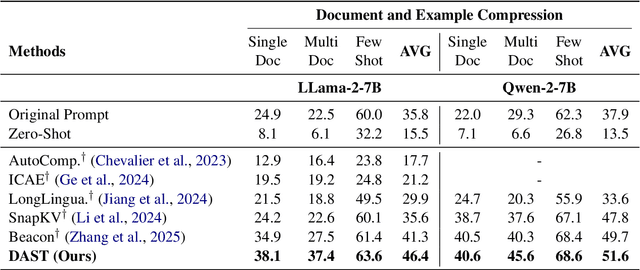
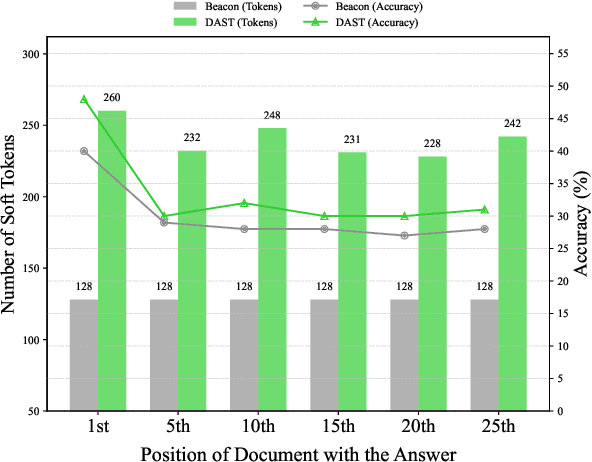
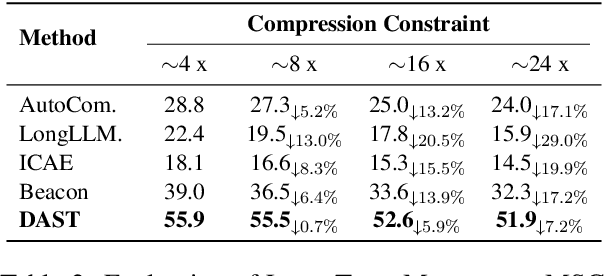
Abstract:Large Language Models (LLMs) face computational inefficiencies and redundant processing when handling long context inputs, prompting a focus on compression techniques. While existing semantic vector-based compression methods achieve promising performance, these methods fail to account for the intrinsic information density variations between context chunks, instead allocating soft tokens uniformly across context chunks. This uniform distribution inevitably diminishes allocation to information-critical regions. To address this, we propose Dynamic Allocation of Soft Tokens (DAST), a simple yet effective method that leverages the LLM's intrinsic understanding of contextual relevance to guide compression. DAST combines perplexity-based local information with attention-driven global information to dynamically allocate soft tokens to the informative-rich chunks, enabling effective, context-aware compression. Experimental results across multiple benchmarks demonstrate that DAST surpasses state-of-the-art methods.
Refine Knowledge of Large Language Models via Adaptive Contrastive Learning
Feb 11, 2025Abstract:How to alleviate the hallucinations of Large Language Models (LLMs) has always been the fundamental goal pursued by the LLMs research community. Looking through numerous hallucination-related studies, a mainstream category of methods is to reduce hallucinations by optimizing the knowledge representation of LLMs to change their output. Considering that the core focus of these works is the knowledge acquired by models, and knowledge has long been a central theme in human societal progress, we believe that the process of models refining knowledge can greatly benefit from the way humans learn. In our work, by imitating the human learning process, we design an Adaptive Contrastive Learning strategy. Our method flexibly constructs different positive and negative samples for contrastive learning based on LLMs' actual mastery of knowledge. This strategy helps LLMs consolidate the correct knowledge they already possess, deepen their understanding of the correct knowledge they have encountered but not fully grasped, forget the incorrect knowledge they previously learned, and honestly acknowledge the knowledge they lack. Extensive experiments and detailed analyses on widely used datasets demonstrate the effectiveness of our method.
Cold-Start Recommendation towards the Era of Large Language Models (LLMs): A Comprehensive Survey and Roadmap
Jan 03, 2025Abstract:Cold-start problem is one of the long-standing challenges in recommender systems, focusing on accurately modeling new or interaction-limited users or items to provide better recommendations. Due to the diversification of internet platforms and the exponential growth of users and items, the importance of cold-start recommendation (CSR) is becoming increasingly evident. At the same time, large language models (LLMs) have achieved tremendous success and possess strong capabilities in modeling user and item information, providing new potential for cold-start recommendations. However, the research community on CSR still lacks a comprehensive review and reflection in this field. Based on this, in this paper, we stand in the context of the era of large language models and provide a comprehensive review and discussion on the roadmap, related literature, and future directions of CSR. Specifically, we have conducted an exploration of the development path of how existing CSR utilizes information, from content features, graph relations, and domain information, to the world knowledge possessed by large language models, aiming to provide new insights for both the research and industrial communities on CSR. Related resources of cold-start recommendations are collected and continuously updated for the community in https://github.com/YuanchenBei/Awesome-Cold-Start-Recommendation.
Loss-Aware Curriculum Learning for Chinese Grammatical Error Correction
Dec 31, 2024Abstract:Chinese grammatical error correction (CGEC) aims to detect and correct errors in the input Chinese sentences. Recently, Pre-trained Language Models (PLMS) have been employed to improve the performance. However, current approaches ignore that correction difficulty varies across different instances and treat these samples equally, enhancing the challenge of model learning. To address this problem, we propose a multi-granularity Curriculum Learning (CL) framework. Specifically, we first calculate the correction difficulty of these samples and feed them into the model from easy to hard batch by batch. Then Instance-Level CL is employed to help the model optimize in the appropriate direction automatically by regulating the loss function. Extensive experimental results and comprehensive analyses of various datasets prove the effectiveness of our method.
 Add to Chrome
Add to Chrome Add to Firefox
Add to Firefox Add to Edge
Add to Edge